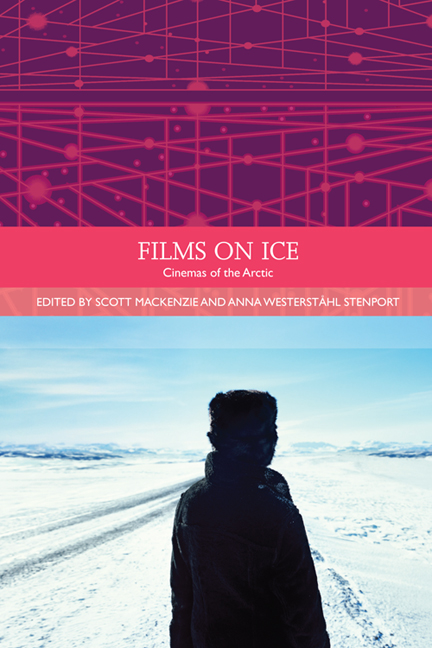Book contents
- Frontmatter
- Contents
- List of Illustrations
- Acknowledgements
- Traditions in World Cinema
- Introduction: What are Arctic Cinemas?
- PART I GLOBAL INDIGENEITY
- PART II HOLLYWOOD HEGEMONY
- PART III ETHNOGRAPHY AND THE DOCUMENTARY DILEMMA
- 14 The Creative Treatment of Alterity: Nanook as the North
- 15 From Objects to Actors: Knud Rasmussen's Ethnographic Feature Film The Wedding of Palo
- 16 Arctic Travelogues: Conquering the Soviet North
- 17 A Gentle Gaze on the Colony: Jette Bang's Documentary Filming in Greenland 1938–9
- 18 Exercise Musk-Ox: The Challenges of Filming a Military Expedition in Canada's Arctic
- 19 The Tour: A Film About Longyearbyen, Svalbard. An Interview with Eva la Cour
- PART IV MYTHS AND MODES OF EXPLORATION
- Notes on the Contributors
- Index
16 - Arctic Travelogues: Conquering the Soviet North
from PART III - ETHNOGRAPHY AND THE DOCUMENTARY DILEMMA
Published online by Cambridge University Press: 05 September 2016
- Frontmatter
- Contents
- List of Illustrations
- Acknowledgements
- Traditions in World Cinema
- Introduction: What are Arctic Cinemas?
- PART I GLOBAL INDIGENEITY
- PART II HOLLYWOOD HEGEMONY
- PART III ETHNOGRAPHY AND THE DOCUMENTARY DILEMMA
- 14 The Creative Treatment of Alterity: Nanook as the North
- 15 From Objects to Actors: Knud Rasmussen's Ethnographic Feature Film The Wedding of Palo
- 16 Arctic Travelogues: Conquering the Soviet North
- 17 A Gentle Gaze on the Colony: Jette Bang's Documentary Filming in Greenland 1938–9
- 18 Exercise Musk-Ox: The Challenges of Filming a Military Expedition in Canada's Arctic
- 19 The Tour: A Film About Longyearbyen, Svalbard. An Interview with Eva la Cour
- PART IV MYTHS AND MODES OF EXPLORATION
- Notes on the Contributors
- Index
Summary
Early Soviet policies towards the numerically small Northern and Far Eastern indigenous populations emerged from a nineteenth-century populist framework that saw cultural extinction as a major problem (Kuper 1988: 2–3). In the early 1920s, the Soviet press frequently presented the situation of the indigenous population of the North as ‘worsening’, ‘becoming harder’, and finally reaching a ‘catastrophic’ stage (cf. Ianovich 1923: 251–4; Slezkine 1994: 131–83). Soviet nationality policy, defined by Francine Hirsch as a ‘state-sponsored evolutionism’, grounded the Soviet ‘civilizing mission’ in the Marxist concept of development through historical stages (Hirsch 2005: 7). Within this framework, the indigenous peoples were seen both as underdeveloped societies to be modernised and as complex cultures worthy of extensive ethnographic research. Nineteenth-century romantic primitivism fused with positivism resulted in a peculiar view of indigenous populations as a ‘combination of the contemptible and the admirable’, in which ‘the native might be rebuked for eating rotten fish, abusing his wife, and killing his elderly parents, but he absolutely had to be praised for his simplicity, generosity, and stoicism’ (Slezkine 1994: 79).
Cinematography, as the Bolsheviks well knew, was a powerful tool for visualising diversity and demonstrating desired developments and achievements. In the Soviet context, the ‘disappearing’ minorities were supposed to benefit from the new regime, at least on screen. The landscape they inhabited was imagined as a complex composite: a territory rich in material resources and an underdeveloped land; a home to endangered peoples; a vulnerable frontier; and the futuristic venue for an anticipated economic miracle. This chapter outlines the evolution of the imagery of indigenous populations and the Arctic North in the Soviet cinema of the 1920–30s. By focusing on the films by Vladimir Erofeev and Vladimir Shneiderov, I trace the transformation of the visual language of representation of the Far North. This transitioned over the course of a few decades from being represented as an exotic borderland with a variety of cultures to a harsh but tameable frontier in which the image of the indigenous population becomes that of a body of diligent apprentices.
- Type
- Chapter
- Information
- Films on IceCinemas of the Arctic, pp. 222 - 234Publisher: Edinburgh University PressPrint publication year: 2014



